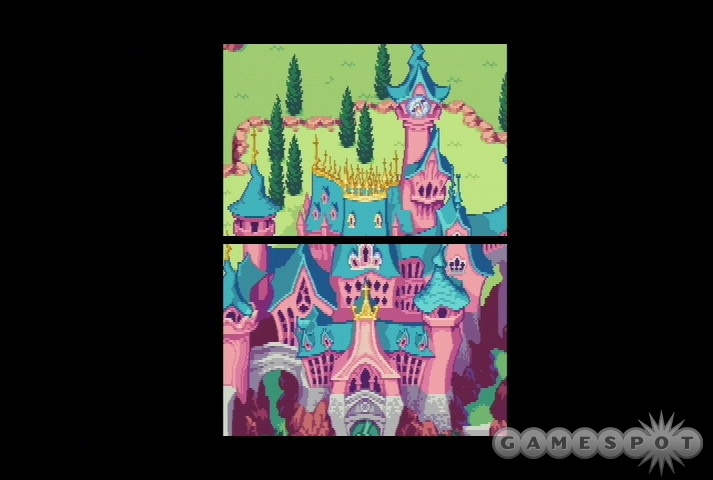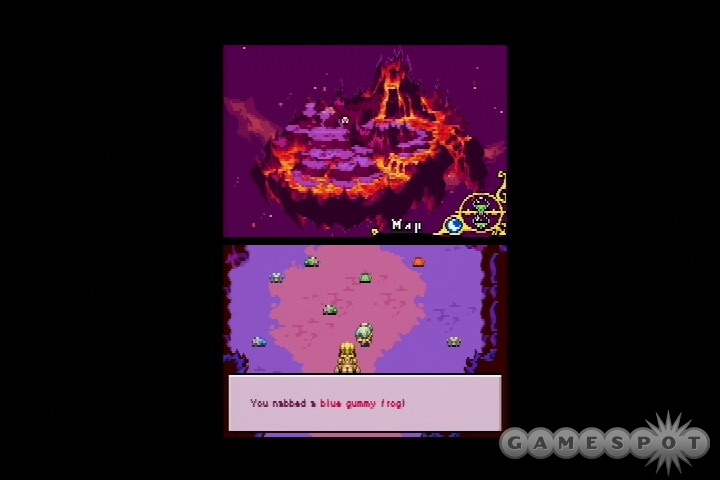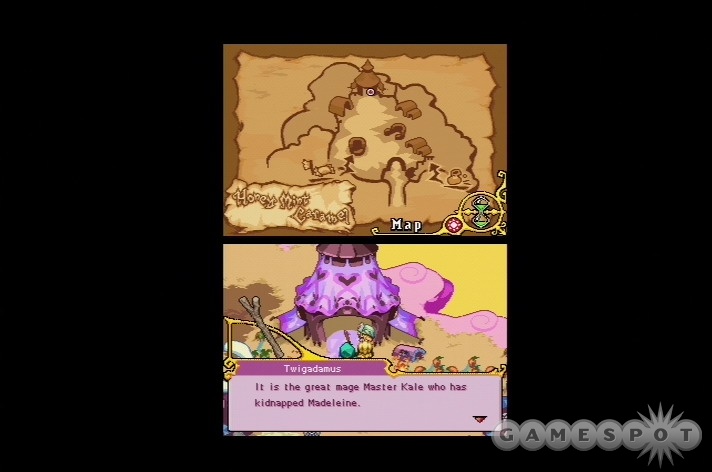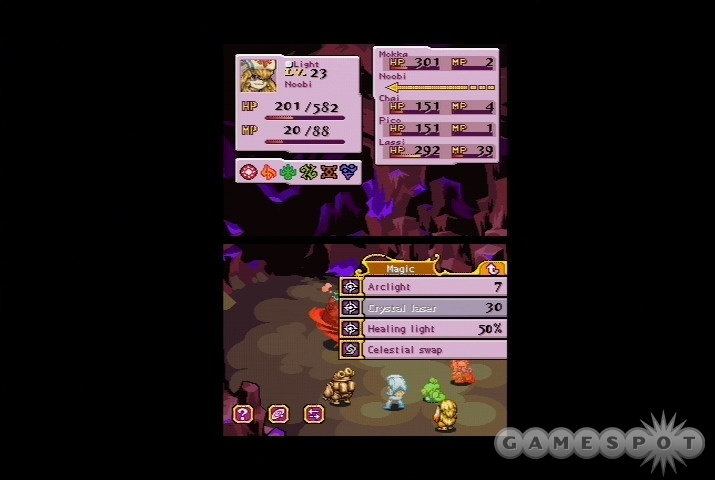Magical Starsign is a colorful and lighthearted role-playing game that tries its very best to charm you right out of the gate. From the overly cutesy art style to the game's amusing penchant for naming characters after foods, there's almost always something to make you smile. While its starsign-based, sometimes awkwardly paced battle system and simplistic storyline are short on depth, there's enough personality filling the niches to keep this little RPG appealing.

Our assorted heroes and heroines start off at the Will-O'-Wisp Academy, studying magic under the tutelage of the bright, if absentminded, instructor, Miss Madeline. The kids overhear Miss Madeline and the Academy's principal chatting about an urgent matter that would send Madeline off their homeworld of Kovomaka to the wind planet, Puffoon. When their beloved teacher doesn't return after three months, the industrious lop-eared Lassi takes it upon herself to search out the school's legendary hidden rocket ships. Upon discovering the vessels, the kids climb on in without a second thought, and before you can say "magic school bus," they're launched into space and scattered among the Baklava system's many diverse worlds. It's a basic good-versus-evil adventure that would get pretty dull if it wasn't for the occasional jolt of inspiration, like discovering the Space Police is a paperwork-based organization that doesn't actually take action on crime or traveling to seek wisdom from a sage that ends up being a possessed, floating stick.
Each of the characters in Magical Starsign controls magic derived from the elements embodied by Baklava's planets. The robot Mokka has an affinity for earth, the energetic Pico has an affinity for fire, the serene salamander Chai has an affinity for wood, and so on. Each element has its own strength and weakness, like how water is weaker than earth but trumps fire. Your own character in the game--you can choose a boy or a girl, and name yourself--has a choice of a special light or dark affinity. Light and dark oppose each other directly while not affecting any of the other elemental signs, which has implications for the game's battle system.
The bottom screen of the DS is where you'll do all your exploring of the bright, cartoonish world, and while you can technically use both the D pad and the face buttons to move, it's easiest by far to maneuver about by tapping the stylus in the direction that you want to travel in. Magical Starsign completely abandons almost every button on the DS in favor of the touch screen, and on the whole it works well, especially for browsing menus in the field and in battle. Navigation in the world can be a little on the cranky side when trying to move around various obstacles, since you can easily send your party dashing on a tangent and then have to route them back. You can also cast elemental spells to help solve puzzles by selecting them from the bottom of the screen, and you can collect items strewn across the landscape, like rainbow shells and delicious gummi frogs. The top screen serves as a continuance of scenery a lot of the time, but you can also pop up a number of different world maps, status updates, and other such helper screens that keep your adventure streamlined.
You'll hit battles randomly as you explore the various (small) planets, bringing up to six characters into battle at a time. You can arrange your party into front and back rows, where the front row can perform melee strikes as well as single-target spells and the back row cannot melee but can instead hit all foes with a single spellcast. When casting a spell from the back row, its damage is spread out across all enemies, so its effects are less potent than a single-target cast. As you might imagine, it's advantageous to coordinate your turn-based magical attacks to attempt to take advantage of enemy weaknesses, though there's an added wrinkle, and that's planetary auras.

As the elemental planets move through space, their powers get a temporary boost when they're aligned with certain regions of their orbit. Thusly, when the fire planet receives its fire aura, any fire-affinity character also receives a power enhancement. You can check where the planets are at any given time through the "astrolog" screen, which you can bring up on the DS's top screen during battle. You can even use a special spell called celestial swap to use a character's magic points in an attempt to swing the planets into advantageous positions.
This sounds fairly strategic, but most of the time you can ignore the planetary alignments, toss out spells, and do just fine. Not only do auras boost spell power, but you can also tap your characters with the stylus during a particular point in their spellcast to give them extra power. A character with a planetary aura active will glow, and they'll hit even foes they should be weak against for a good amount of damage. The only point at which things can get tricky is during boss battles, which can run hot and cold as far as difficulty goes. And even if you've got a handle on the elemental magic, there's always light and dark to deal with.
Your main character has either a light or dark magical affinity, and it's attached to the game's time-based day/night cycle. Light characters are strong during the day and weak at night, while the opposite is true for dark affinity. However, since light and dark operate on something of a schedule, if you happen to have a light hero and hit a dark magic boss at night, you can expect to get hit for ridiculous damage and be almost powerless to mitigate it. Another issue with the battle system is that, while the developer tried to help streamline matters with an option that repeats your last action, casting animations and such don't get any faster, especially when you have to watch each of them carefully to get the magic-boosting tap off at the right time. As a result, you'll stare at the single casting animation over and over again, wishing you could urge the process to go just a wee bit more quickly.
Magical Starsign has a distinctive, cartoonish feel to it, with the various characters and animal races meshing traditional anime looks with overexaggerated features and outlandish outfits. The worlds you'll explore each have their own flavor, though they tend to be fairly small and don't have much of a variety of environments within a particular planet. The game's music is upbeat without being particularly memorable, and the battle music in particular loops a good deal.

At least it's fairly meaty for a handheld adventure, clocking in at around 20 hours for a full experience. There are numerous little items to collect along the way, some bonus dungeons to explore, and some interesting wireless multiplayer offerings. If you meet up with a friend who owns Magical Starsign through tag mode, you can exchange Amigo info and earn items and eggs. You can incubate eggs in your rocket ship, and when they hatch, you'll get a special "egg character" that you can use in multiplayer games as well as the single-player game--although egg characters won't level in single-player, which is a shame. Multiplayer dungeons let you compete directly against your friend for items and other prizes, though there aren't all that many dungeons to choose from, and the bigger the level gap between you and your friend, the more lopsided the game will be.
Magical Starsign offers up a quirky cast and some genuine humor, and while the battles aren't all that nuanced, they're easy to grasp. Younger role-players and those who can appreciate a cute script, a world that positively brims with gummi frogs ripe for the picking, and talking pottery might consider making room in their DS for this magical journey.
As the elemental planets move through space, their powers get a temporary boost when they're aligned with certain regions of their orbit. Thusly, when the fire planet receives its fire aura, any fire-affinity character also receives a power enhancement. You can check where the planets are at any given time through the "astrolog" screen, which you can bring up on the DS's top screen during battle. You can even use a special spell called celestial swap to use a character's magic points in an attempt to swing the planets into advantageous positions.

This sounds fairly strategic, but most of the time you can ignore the planetary alignments, toss out spells, and do just fine. Not only do auras boost spell power, but you can also tap your characters with the stylus during a particular point in their spellcast to give them extra power. A character with a planetary aura active will glow, and they'll hit even foes they should be weak against for a good amount of damage. The only point at which things can get tricky is during boss battles, which can run hot and cold as far as difficulty goes. And even if you've got a handle on the elemental magic, there's always light and dark to deal with.
Your main character has either a light or dark magical affinity, and it's attached to the game's time-based day/night cycle. Light characters are strong during the day and weak at night, while the opposite is true for dark affinity. However, since light and dark operate on something of a schedule, if you happen to have a light hero and hit a dark magic boss at night, you can expect to get hit for ridiculous damage and be almost powerless to mitigate it. Another issue with the battle system is that, while the developer tried to help streamline matters with an option that repeats your last action, casting animations and such don't get any faster, especially when you have to watch each of them carefully to get the magic-boosting tap off at the right time. As a result, you'll stare at the single casting animation over and over again, wishing you could urge the process to go just a wee bit more quickly.
Magical Starsign has a distinctive, cartoonish feel to it, with the various characters and animal races meshing traditional anime looks with overexaggerated features and outlandish outfits. The worlds you'll explore each have their own flavor, though they tend to be fairly small and don't have much of a variety of environments within a particular planet. The game's music is upbeat without being particularly memorable, and the battle music in particular loops a good deal.

At least it's fairly meaty for a handheld adventure, clocking in at around 20 hours for a full experience. There are numerous little items to collect along the way, some bonus dungeons to explore, and some interesting wireless multiplayer offerings. If you meet up with a friend who owns Magical Starsign through tag mode, you can exchange Amigo info and earn items and eggs. You can incubate eggs in your rocket ship, and when they hatch, you'll get a special "egg character" that you can use in multiplayer games as well as the single-player game--although egg characters won't level in single-player, which is a shame. Multiplayer dungeons let you compete directly against your friend for items and other prizes, though there aren't all that many dungeons to choose from, and the bigger the level gap between you and your friend, the more lopsided the game will be.
Magical Starsign offers up a quirky cast and some genuine humor, and while the battles aren't all that nuanced, they're easy to grasp. Younger role-players and those who can appreciate a cute script, a world that positively brims with gummi frogs ripe for the picking, and talking pottery might consider making room in their DS for this magical journey.